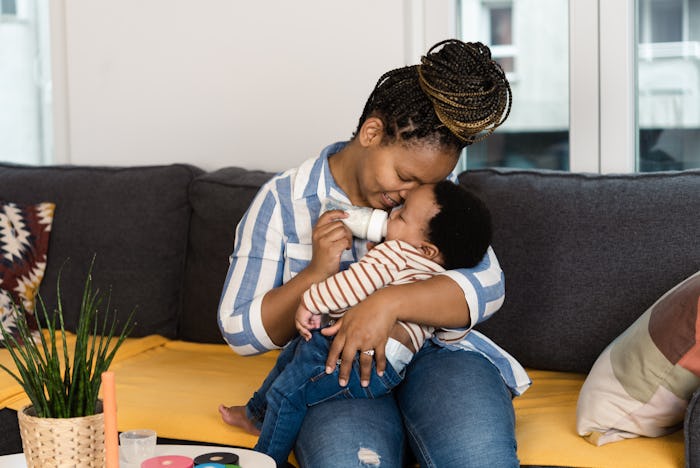Feeding Baby

Here’s Your Guide To Paced Bottle Feeding
Because we all want less spit-up in our lives.
Any parent who bottle feeds their newborn knows that this feeding method comes with its own set of struggles. Since the bottle allows the milk to be readily available, many hungry babies end up gulping it down as fast as possible, meaning that feeding sessions may only last a few minutes. To avoid that, many parents take an interest in paced bottle feeding, a method of slowing down the feeding session that benefits both baby and mom or dad.
While quick feeding sessions might sound ideal for parents who are in a time crunch (and, really, who isn’t?), drinking really fast isn’t great in the long run. When infants gulp down their milk in just a few minutes, they usually end up swallowing large amounts of air or putting themselves at risk for overfeeding, which can result in some gas, tummy discomfort, and extra spit-up right after. There’s no need to rush through a feed, and paced bottle feeding can be a great solution to keep your little one drinking slow and steady. It does require some effort from the parent or caretaker — you’ll need to keep your focus on them throughout the feed — but it’s worth it in the end.
What is paced bottle feeding?
Paced bottle feeding is a method of slowing down a feeding to give the infant more control. “It allows the person bottle feeding to slow down the flow of milk into the bottle, nipple, and mouth of the infant, which helps the infant individually control his/her suck, swallow, and breathing coordination,” explains Deedra Franke, registered nurse, International Board Certified Lactation Consultant at Mercy Medical Center. Franke recommends paced bottle feeding for any baby using a bottle, whether it holds breast milk or formula.
Why do people do paced bottle feeding?
The main goal of paced bottle feeding is to slow down feeding sessions and give the baby more control, and as Franke notes, it helps prevent issues like overfeeding.
Parents who nurse and bottle feed may try paced bottle feeding to make bottle feeding feel more similar to breastfeeding. Paced bottle feeding is supposed to be a way to make bottle feeding mimic breastfeeding, which generally goes at a slower pace, notes Dr. Victoria Regan, pediatrician at Children’s Memorial Hermann Hospital in Houston, Texas. It can be a good way to get them used to both methods of feeding.
A slower feed usually leads to less discomfort, too, so parents of babies with tummy issues may find it helpful. “It may help babies who are excessively gassy or have reflux/spitting up frequently,” Regan says.
How to do paced bottle feeding
We’re all guilty of using a feeding session to check out for a few minutes and scroll through Instagram or relax, and there’s nothing wrong with that. But paced bottle feeding requires a little more attention and effort. Regan and Franke walk us through the steps to do it successfully:
- Hold baby in your lap in a semi-upright position, supporting their head and neck, rather than lying them back.
- Insert the bottle nipple into baby’s mouth, keeping it in a horizontal position or flat to the floor.
- Regan suggests having baby begin sucking from the nipple before milk is in it, ensuring they have a good latch, then tipping the bottle gently so that the nipple is about half full. You’ll want to keep it half full the entire feed.
- Let baby feed for 20 to 30-second intervals, getting three to five full swallows, with about five-second breaks in between. Tip the bottle down during breaks.
- Continue doing this until baby appears full. That means no longer wanting to suckle, turning away from the bottle, etc., Regan says.
Ideally, Regan notes, baby will begin taking breaks and restarting feeds on their own after three to five days of doing this.
How long should paced bottle feeding take?
Paced bottle feeding is slow, but not overwhelmingly so. “[The length of time] is dependent on the baby and volume of milk they consume,” Regan says. “On average, feedings take 10 to 20 minutes.”
When to stop paced bottle feeding
This feeding method shouldn’t be a one or two time thing — ideally, it should become the way baby always feeds. Franke recommends doing it as long as baby is taking a bottle. And as babies adjust to this feeding method, it’s something they should pick up and put into practice on their own. It’s also something they’ll stop when necessary. “As the baby will learn this pattern after a few days and pace themselves, they will also stop paced feedings when they are ready,” Regan says. At 12- months old, when they begin to wean off a bottle, paced bottle feeding is no longer necessary.
Best bottles for paced bottle feeding
You can use any bottle to try paced bottle feeding, but both Regan and Franke recommend using slow flow nipples. These make it easier to control the flow of breast milk or formula, making the whole practice just a little bit more simple for everyone. Below are a few great options worth checking out.
We may receive a portion of sales if you purchase a product through a link in this article.
Paced bottle feeding is a great way to slow down feeding sessions, leaving your baby feeling more full and more comfortable without risk of overfeeding or digestion issues. There are really no disadvantages to trying it, and it could positively change the way your baby feeds. If your little one seems like they’re drinking too fast, this is an excellent solution.
Experts:
Deedra Franke, Registered Nurse, International Board Certified Lactation Consultant at Mercy Medical Center
Dr. Victoria Regan, pediatrician at Children’s Memorial Hermann Hospital in Houston, Texas
This article was originally published on